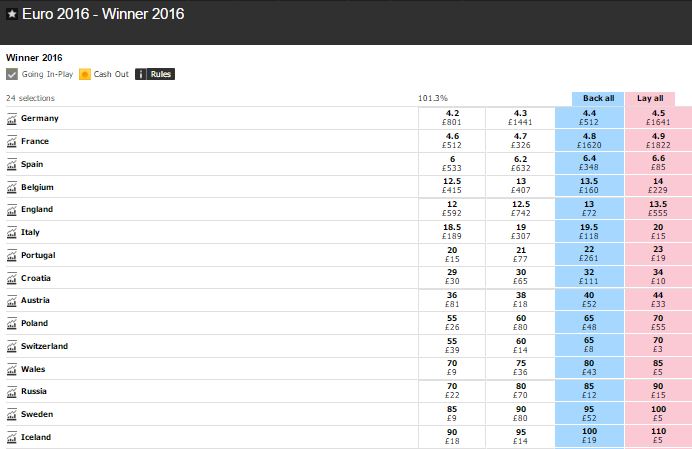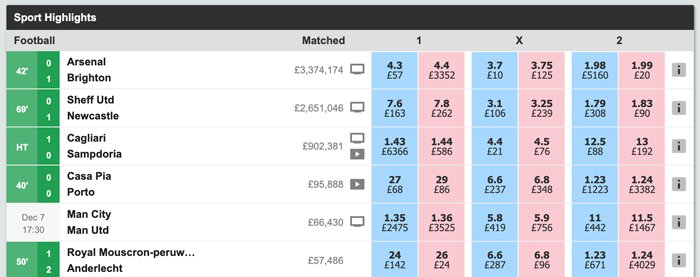With a back-to-lay bet, also known as a D.O.B. (Double Or Bust) is where you would back a selection first at a certain price before the event, in our case a horse and lay it off after at a shorter price in-running to make a profit.

Back-To-Lay Bets. With a back-to-lay bet, also known as a D.O.B. (Double Or Bust) is where you would back a selection first at a certain price before the event, in our case a horse and lay it off after at a shorter price in-running to make a profit.
- In every betting exchange platform there are three odds on “back” and “lay” selections. Of course the “lay” selection can never be lower than the “back” at the same time; otherwise there would be a surebet.
- Lay odds – the odds which you are prepared to give someone wanting to place a Back bet. Backer’s Stake – the amount you are prepared to let the backer bet with you. This is your potential winnings. Liability – (Lay.
Why Would You Back-To-Lay
Finding winners is incredibly hard but predicting how horses will run can be more reliable and this is something you can profit from.
If you could back a horse at 10.0 for £10 and lay back at 5.0 for £20 you would be guaranteed to make £10 whether the horse won or lost – this is what’s sometimes referred to as Dobbing. You would only lose if your lay bet doesn’t get matched.

The key to this been a profitable approach is to identify horses that will trade short in-running when we would be looking to lay our bet back at shorter odds and for a bigger stake than the back bet we placed pre-race.
Front-runners will often trade low in races (the horse leading in the image above is a well known front-runner caled Safety Check, see the graph below of the price he trades at in running from a Betfair SP of 38.0 to 3.05 in-running) while some horses can travel extremely well in their races and challenge late on but not sustain what looks a race winning move. These are the types of horses we need to be able to identify to profit from.
One way to identify horses that we can profit from is to investigate their in-running trading histories which can be found on www.winningwarlock.com free-of-charge . If they have traded consistently low previously there’s a good chance they will do so again.
You also need to make sure the race it is running in is similar to the types of races it has performed well in the past, the distance, the ground, the class of race and is it race-fit? If it is a front-runner and there are other front-runners in the race this would be problematic as it may not lead or could go off too fast and race the other front-runner for the lead. You can check the horses form on www.racingpost.com for free.
You have the option of either doing a straight DOB and doubling you investment or trying to lay back at a much shorter price. If the horse has traded at less than 20% of its starting price on many occasions and been beaten you could try it for a bigger profit. You could back your selection at 10.0 for £10 and lay back at 2.7 for £50 so if you bet was matched it would make you a £40 profit if it was beaten and £5 if it went on to win the race.
21 Jan 2015Lay Betting Explained
Lay betting is an option on exchanges like Betfair where bettors can play the role of the bookmaker and back something not to happen. Punters offer odds to sell a bet instead of to back a bet. It is one component of matched betting, where punters both back and sell bets on the same game to guarantee a win.
- When you lay a bet, you are betting on something to not happen
- Lay bets are made on exchanges such as Betfair
- Our comprehensive guide takes you step-by-step
Lay betting allows you to ‘be the bookie’. Rather than backing a selection to win, lay betting enables you to bet on something to not happen.
For instance, you may not know which side will win the Premier League title but you think you have a good idea which side won’t win it. In this instance, a lay bet might be right for you.
Lay betting would allow you to bet on that team to not win the league. If anyone else wins the Premier League, then you win your bet. If they do win the league, then, of course, you would lose.
What Does Liability in Lay Betting Mean?
Liability is an important concept to understand when learning about lay betting. When you conventionally back a horse to win, the amount of money you can lose is your stake. I.e. if you bet £10 on a horse to win and it comes 3rd, it is only £10 you can lose.
This is different in lay betting.
Think of yourself as the bookmaker. If you lose your bet, the bookmaker keeps your stake. If you win, then the bookmaker has to pay out your winnings. It can be a lot more than your original stake.
This is same as laying a bet. If the selection does win, you have to pay out the winnings. That potential payout is known as your liability. It how much you need to pay out if you lose your bet.
Example 1) You lay a horse at 3.00
- You lay a horse at 3.00
- The backer’s stake is £10
- Your liability is £20

In this example, if any other horse wins, then you win the losing stake of £10. The horse is priced at 3.00. If the horse wins the race, then your liability is equal to the winnings for the backer. This is £20. It is only the winnings you pay, as the backer’s original stake is returned to them.
Back And Lay Betting Sites Without
Example 2) You lay a horse at 5.00
- You lay a horse at 5.00
- The backer’s stake is £20
- Your liability is £80
In this example, if any other horse wins, then you win the losing stake of £20. The horse is priced at 5.00. If the horse wins the race, then your liability is equal to the winnings for the backer. This is £80. It is only the winnings you pay, as the backer’s original stake is returned to them.
Example 3) You lay a horse at 27.00
Back Vs Lay
- You lay a horse at 27.00
- The backer’s stake is £10
- Your liability is £260
We wanted to put in this example since it shows how liability can quickly grow. In this case, laying this bet would generate a potential return of £10. At odds of 27.00, probability dictates that this horse is unlikely to win, but if it does, the liability is £260. When laying bets at high prices, one has to consider whether the chance of gaining £10 is worth the risk of losing £260.
What Does Laying Off a Bet Mean?
This is different. Laying off a bet refers to betting against something you have already backed.
For example, say you back Newcastle at 8.00 to beat Chelsea before the match starts. During the game, they take a surprise 2-0 lead. The odds for Newcastle to win this game shorten.
You can choose to now ‘lay off’ this bet. By laying the same bet as you back, you are betting both on it to happen, and for it not happen. Because the odds have got shorter, you are guaranteed profit for doing so. This is similar to cashing out your bet earlier. Laying off your bet allows you to take reduced, but guaranteed winnings.
Is Lay Betting Legal?
Back And Lay Betting Sites Against
Matched betting is legal in the United Kingdom. Just be sure to only use sites that are certified with the UK Gambling Commission. All of the sites we recommend follow the criteria.
Free Lay Betting Systems
Summary
When you lay a bet, you are betting on something to not happen. If the selection loses then you win the backer’s stake. However, if it wins then you pay the winnings. This is known as the liability, i.e. how much you will potentially have to pay out.



